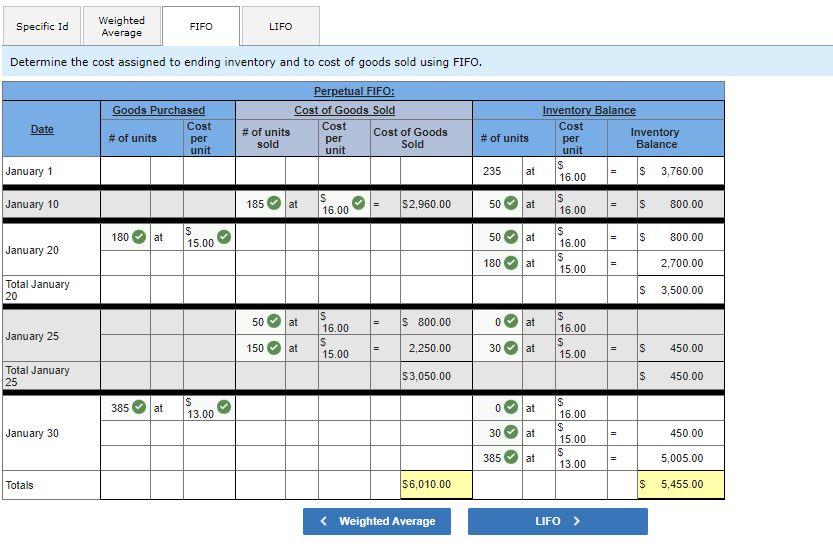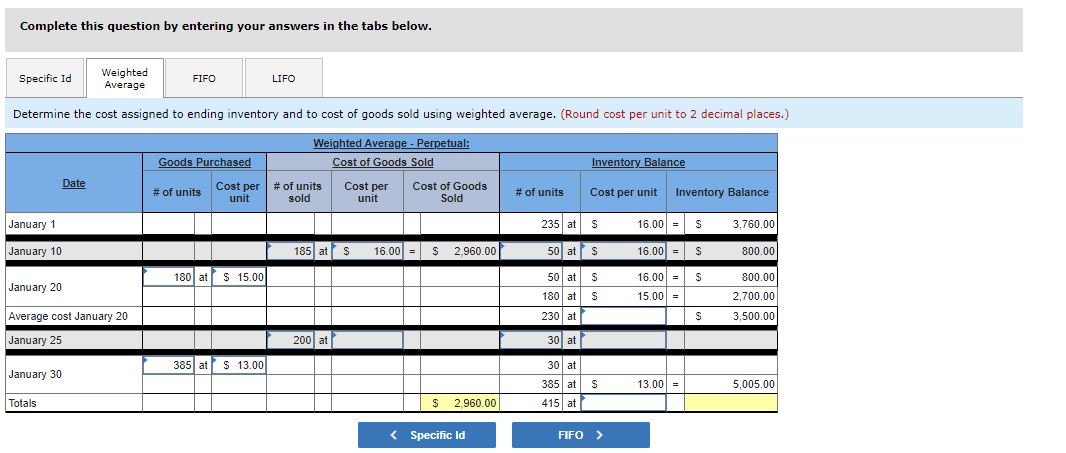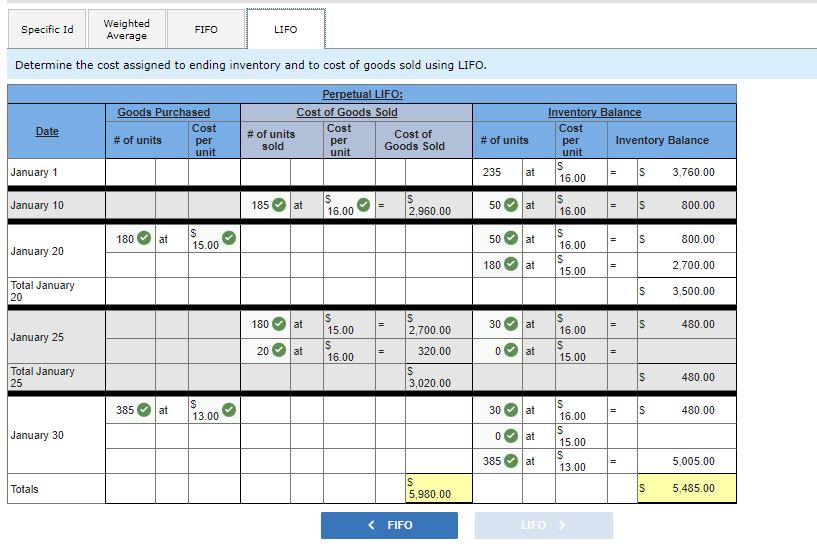Answered step by step
Verified Expert Solution
Question
1 Approved Answer
Laker Company reported the following January purchases and sales data for its only product. The Company uses a perpetual inventory system. For specific Identification,




Laker Company reported the following January purchases and sales data for its only product. The Company uses a perpetual inventory system. For specific Identification, ending Inventory consists of 385 units from the January 30 purchase, 5 units from the January 20 purchase, and 25 units from beginning inventory. Date January 1 January 10 Activities Beginning inventory Sales January 20 Purchase January 25 January 30 Sales Purchase Totals Required: Units Acquired at Cost 235 units $ 16.00- Units sold at Retail $ 3,760 185 units @ $ 25.00 180 units $ 15.00 - 2,700 200 units $ 25.00 385 units 800 units $13.00= 5,005 $ 11,465 385 units 1. Complete the table to determine the cost assigned to ending inventory and cost of goods sold using specific identification. 2. Determine the cost assigned to ending inventory and to cost of goods sold using weighted average. 3. Determine the cost assigned to ending inventory and to cost of goods sold using FIFO. 4. Determine the cost assigned to ending inventory and to cost of goods sold using LIFO. Complete this question by entering your answers in the tabs below. Specific Id Weighted Average FIFO LIFO Complete the table to determine the cost assigned to ending inventory and cost of goods sold using specific identification. Specific Identification Available for Sale Cost of Goods Sold Ending Inventory Purchase Date Activity # of units Cost Per Unit # of units sold Cost Per Unit COGS Ending Inventory. Units Cost Per Unit Ending Inventory. Cost January 11 January 20 Beginning inventory Purchase 235 S 16.00 180 $ 15.00 25 S 5 S 16.00 S 15.00 400 75 January 30 Purchase 385 S 13.00 0 800 0 $ 0 30 $ 475 Specific Id Weighted Average FIFO LIFO Determine the cost assigned to ending inventory and to cost of goods sold using FIFO. Goods Purchased Perpetual FIFO: Cost of Goods Sold Date Cost Cost # of units # of units per sold unit per unit Cost of Goods Sold Cost # of units per unit January 1 $ 235 at = 16.00 January 10 S 185 at 16.00 $2,960.00 50 50 > S at = Inventory Balance Inventory Balance 69 3,760.00 800.00 16.00 $ 180 at 15.00 January 201 Total January 20 S 50 at = 16.00 69 69 $ 180 at = 15.00 800.00 2,700.00 3,500.00 January 25 Total January 25 January 30 Totals S 385 at 13.00 S 50 at = $ 800.00 0 16.00 S 150 at = 2,250.00 30 15.00 $3,050.00 1 1 at $ 16.00 S at |= 15.00 0 1 $ at 16.00 $ 30 at 15.00 S 385 at = 13.00 $6,010.00 < Weighted Average LIFO > 69 69 69 450.00 450.00 450.00 5,005.00 $ 5,455.00 Complete this question by entering your answers in the tabs below. Specific Id Weighted Average FIFO LIFO Determine the cost assigned to ending inventory and to cost of goods sold using weighted average. (Round cost per unit to 2 decimal places.) Weighted Average - Perpetual: Goods Purchased Cost of Goods Sold Inventory Balance Date # of units Cost per # of units unit sold Cost per Cost of Goods # of units Cost per unit Inventory Balance unit Sold January 1 January 10 January 20 235 at $ 16.00 = $ 3,760.00 185 at $ 16.00 = $ 2,960.00 50 at $ 16.00 = $ 800.00 180 at $ 15.00 50 at $ 16.00 = $ 180 at $ 15.00 = 800.00 2,700.00 Average cost January 20 January 25 230 at $ 3,500.00 200 at 385 at $ 13.00 30 at 30 at January 30 Totals $ 2,960.00 385 at 415 at $ 13.00- 5,005.00 < Specific Id FIFO > Specific Id Weighted Average FIFO LIFO Determine the cost assigned to ending inventory and to cost of goods sold using LIFO. Perpetual LIFO: Goods Purchased Cost of Goods Sold Date Cost Cost Cost # of units # of units per sold unit per unit Cost of Goods Sold # of units per Inventory Balance Inventory Balance unit S January 1 235 at = S 3,760.00 16.00 January 10 S S 185 at = 16.00 2,960.00 50 50 > S at = S 800.00 16.00 $ 180 at 15.00 January 20 Total January 20 January 25 Total January 25 January 30 Totals $ 385 at 13.00 S 50 at = S 800.00 16.00 180 at S 15.00 = 2,700.00 S 3,500.00 180 at S 15.00 |= S 2,700.00 30 at S 16.00 = S 60 480.00 S 20 at S = 16.00 320.00 0 at = 15.00 S S 480.00 3,020.00 S 30 at = S 480.00 16.00 S 0 at 15.00 S 385 at = 13.00 S 5,980.00 5,005.00 S 5,485.00 < FIFO LIFO >>
Step by Step Solution
There are 3 Steps involved in it
Step: 1
To determine the cost assigned to ending inventory and cost of goods sold using specific identification we match the units sold with their respective purchase costs Lets complete the table Specific Id...
Get Instant Access to Expert-Tailored Solutions
See step-by-step solutions with expert insights and AI powered tools for academic success
Step: 2

Step: 3

Ace Your Homework with AI
Get the answers you need in no time with our AI-driven, step-by-step assistance
Get Started


